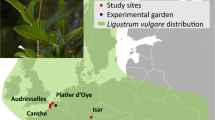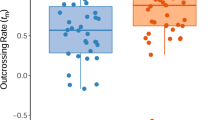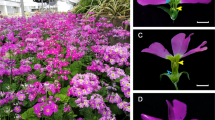Abstract
There has been extensive theoretical study of the evolution of self-fertilization in hermaphroditic or monoecious flowering plants because self-compatible species with high rates of self-fertilization are often derived from outcrossing ancestors1–4. Such studies have shown that a gene causing an increased rate of self-fertilization has an advantage because the mother transmits genes via both pollen and egg to selfed progeny5, and thereby evades the ‘cost of meiosis’6–8. Selfing also may be advantageous if the amount of pollen available to fertilize ovules by outcrossing is limited1,2,4,6. However, these advantages are offset, at least partially, if the fitness of selfed progeny is lower than that of outcrossed progeny, due to inbreeding depression1,2,6,7,9,10. Biogeographical evidence suggests that reduced pollinator activity may be sufficient to counteract this disadvantage and permit the evolution of selfing in populations in ecologically marginal areas1–4, but direct evidence is usually lacking. Here we show that the self-fertile homostyle variant of the primrose Primula vulgaris, which reaches high frequencies in certain populations11, experiences a fertility advantage, in terms of seeds per plant, as a result of its high rate of self-fertilization.
This is a preview of subscription content, access via your institution
Access options
Subscribe to this journal
Receive 51 print issues and online access
$199.00 per year
only $3.90 per issue
Buy this article
- Purchase on Springer Link
- Instant access to full article PDF
Prices may be subject to local taxes which are calculated during checkout
Similar content being viewed by others
References
Charlesworth, B. & Charlesworth, D. Am. Nat. 114, 499–513 (1979).
Lloyd, D. G. in Demography and Evolution in Plant Populations (ed. Solbrig, O. T.) 67–88 (Blackwell, Oxford, 1980).
Ernst, A. Oesterr. Bot. 2. 100, 235–255 (1953).
Baker, H. G. Evolution 20, 349–368 (1966).
Fisher, R. A. Ann Eugen. 12, 169–171 (1941).
Maynard Smith, J. The Evolution of Sex (Cambridge University Press, 1978).
Charlesworth, B. J. theor. Biol. 84, 655–671 (1980).
Williams, G. C. Sex and Evolution (Princeton University Press, 1975).
Lande, R. & Schemske, D. W. Evolution (in the press).
Darwin, C. R. The Different Forms of Flowers on Plants of the Same Species (Murray, London, 1877).
Crosby, J. L. Evolution 3, 212–230 (1949).
Crosby, J. L. Heredity 13, 127–131 (1959).
Bodmer, W. F. Phil. Trans. R. Soc. B242, 517–549 (1960).
Brown, A. H. D., Matheson, A. C. & Eldridge, K. G. Aust. J. Bot. 23, 931–939 (1975).
Ennos, R. A. & Clegg, M. T. Heredity 48, 283–292 (1982).
Erdtman, G. Handbook of Palynology (Munksgaard, Copenhagen, 1969).
Ornduff, R. Biol. J. Linn. Soc. Land. 78, 1–10 (1979).
Stephenson, A. G. A Rev. Ecol. Syst. 12, 253–280 (1981).
Charlesworth, D. & Charlesworth, B. Biol. J. Linn. Soc. Land. 15, 57–74 (1981).
Charnov, E. L. The Theory of Sex Allocation (Princeton University Press, 1982).
Author information
Authors and Affiliations
Rights and permissions
About this article
Cite this article
Piper, J., Charlesworth, B. & Charlesworth, D. A high rate of self-fertilization and increased seed fertility of homostyle primroses. Nature 310, 50–51 (1984). https://doi.org/10.1038/310050a0
Received:
Accepted:
Issue Date:
DOI: https://doi.org/10.1038/310050a0
This article is cited by
-
Assessing the genetic diversity of Nymphoides peltata in the native and adventive range using microsatellite markers
Biological Invasions (2023)
-
Deforestation Impacts on Diversity of Orchids with Inference on the Conservation Initiatives: Malaysia Case Study
The Botanical Review (2023)
-
Genetics of distyly and homostyly in a self-compatible Primula
Heredity (2019)
-
Outbreeding depression and breeding system evolution in small, remnant populations of Primula vulgaris: consequences for genetic rescue
Conservation Genetics (2018)
-
Genetic architecture and evolution of the S locus supergene in Primula vulgaris
Nature Plants (2016)
Comments
By submitting a comment you agree to abide by our Terms and Community Guidelines. If you find something abusive or that does not comply with our terms or guidelines please flag it as inappropriate.



